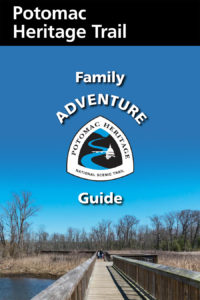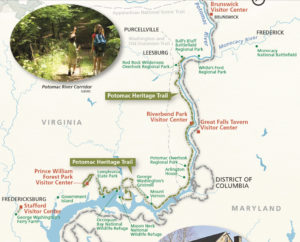 by Rylinn Sorini, Former Potomac Heritage NST Project Intern
by Rylinn Sorini, Former Potomac Heritage NST Project Intern
Edited by Don Briggs, former National Park Service Superintendent for Potomac Heritage National Scenic Trail
When we first began research to create a program for children on the Potomac Heritage National Scenic Trail (PHT), I was presented with a question: How can a Junior Ranger type program encourage children to become conservationists? It’s the big question and the one that drives many of the interpretive and environmental education programs that we have throughout many parks and trail networks.
After digging into the topic, I found that the way to create opportunities for children to become environmentally aware is somewhat simpler than one might think—as early as possible, as much as possible. This may seem obvious, but outdoor experiences are very important in creating conservation attitudes in kids. Value formation occurs at a young age, so the younger children are when they have formative outdoor experiences the better. Large “once in a lifetime” experiences may not actually have as much effect as early and prolonged experiences in the outdoors, especially when accompanied by an influential adult. I set out to create a program that would as easily as possible lay the foundation for future stewards.

The guide features maps and photographs of historic sites and ways families can explore the trail. Screenshot: Family Adventure Guide
Trail administrators face unique challenges when trying to create a program using the “Junior Ranger” label. Trails, in essence, are long, linear parks. This means that resources are often spread thinly along their lengths, which make traditional Junior Ranger programs difficult. Staff in various programs have found a variety of interesting solutions around this problem, including offering all online programs, creating folders with adjustable content sheets for different locations, and publishing several different books for different age groups and visitor centers. From all of these potential models, we decided on what we thought would best fit the needs of the PHT network.
We have created and, with assistance from staff in the National Park Service Harpers Ferry Center, designed the first edition of what we are calling a “Family Adventure Guide.” We are avoiding the “Junior Ranger Program” label because we do not have the resources to distribute a reward system and we are choosing to address a much broader range of age groups. The guide is organized by regions of the PHT network, suggests activities which various ages will naturally choose as interesting and appropriate, and includes a pocket to hold local brochures and maps. All activities encourage interactions with and learning about places associated with PHT-related stories. In the future, the guide could become a series of web pages to which users could submit additional activities.
Learn more and review the guide: www.nps.gov/pohe/planyourvisit/justforkids.htm
Unless otherwise indicated, all material in Pathways Across America is public domain. All views expressed herein are perspectives of individuals working on behalf of the National Trails System and do not necessarily represent the viewpoint of the Federal agencies.